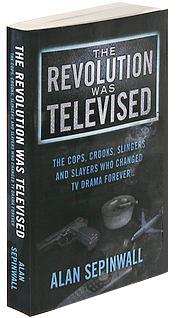It’s the end of August – a last chance to, among other things, dive into fun summer reads. Here at TVWW, that means recent books about TV, which we review starting today…
We’ll start, today, with Alan Sepinwall’s The Revolution was Televised, a book I scarfed as soon as it was published, but never got around to reviewing until now. Too much TV, too little time.
Sepinwall is, by now, a veteran TV critic, and focusing on a media revolution comes naturally to him, because he’s engaged in three media revolutions of his own.
First, shortly after getting a job at New Jersey’s Newark Star-Ledger, he laid claim to a new HBO show called The Sopranos, which was set in locales smack in the middle of his circulation area. By the time The Sopranos cut to black, he had inherited the Sopranos beat, and written so many reviews, feature stories and interviews about David Chase’s cutting-edge drama series that he had ascended to having all but cornered the Sopranos.
When HBO invited fewer than a dozen TV critics to watch the finale a few hours early at HBO’s New York offices, cognizant of our respective papers’ front-page deadline needs, Sepinwall was one of the critics in the darkened screening room that night. I remember, because when the screen went dark at the end, his quiet laughter cut through the silence. How were we supposed to react to that?
Sepinwall’s second revolution, after becoming the television critics’ “Mr. Soprano,” was to dive onto the Internet with indefatigable enthusiasm. By focusing on a few shows he enjoyed and covering and analyzing them obsessively – expanding his Sopranos model – he became, once again, an example of a very focused type of TV criticism. He specialized in the immediately-after-telecast review, and his geometrically increasing band of readers, wherever he wrote, followed him both eagerly and vocally, posting reactions and observations with a similarly fervent enthusiasm.

And now comes Sepinwall’s third revolution: his book,
The Revolution was Televised, which is subtitled
The Cops, Crooks, Slingers and Slayers Who Changed TV Forever. In this case, the revolutionary part of the book isn’t its content, but its distribution system. Just as Sepinwall made an even bigger name for himself on the blogosphere than he had at old-fashioned newspapers (his
“What’s Alan Watching” column, its title taken from an obscure 1989 TV show, now resides prominently at the Hitfix website), he self-published his book, only to have it reviewed by
The New York Times and snapped up by an actual publishing house. That, even more than writing Internet blogs instead of newspaper columns, is a new paradigm, and an achievement as impressive as it is rare.
The Revolution was Televised focuses on a dozen drama series, from HBO’s Oz to AMC’s Breaking Bad, that Sepinwall argues started a TV revolution. His interviews, observations and synopses, vintage and fresh, recount the stories told by these shows, as well as stories about their creations. In most cases, it’s the behind-the-scenes material that’s the most compelling, but fans of these shows – and lots of fans exist, because the titles in question include Buffy the Vampire Slayer, The Wire, Lost and Mad Men – will enjoy it all.
The opening chapter gives a nod to the pre-history of Sepinwall’s revolutionary period – short but due credit to such pre-Oz shows as Hill Street Blues and St. Elsewhere. But the bulk of the book is devoted to, and most valuable as, a trapped-in-amber portrait of the current era of quality television. It’s the era when cable began to dominate the TV drama genre – just before streaming services such as Netflix emerged to change the playing field yet again.
Arguing for the acknowledgment of television as art is a lonely and dirty job, but someone has to do it. And does, every so often, usually as each new wave of TV programming, and excellence, makes the argument even stronger.
Horace Newcomb’s TV: The Most Popular Art, published in 1974 and analyzing such game-changing series as All in the Family, was the first major attempt to put the arguments for TV between two covers. Plenty of smart, valuable books have been written about specific television shows (Mark Dawidziak’s out-of-print 1989 The Columbo Phile being one of the first and best) – but in the decades since Newcomb’s book, there have been only a handful of key works taking a more comprehensive look, a mini-bookshelf which Sepinwall’s Revolution now joins.
There’s MTM: Quality Television, edited by Jane Feuer, Paul Kerr and Tise Vahimagi in 1985; my own Teleliteracy: Taking Television Seriously from 1992 (a bit self-serving, but it’s true), Bob Thompson’s Television’s Second Golden Age (1997), Rob Owen’s Gen X TV: The Brady Bunch to Melrose Place (1999), and a book edited by TVWW contributors Janet McCabe and Kim Akass, Quality TV: Contemporary American Television and Beyond (2007).
And now there’s The Revolution was Televised. The Mad Men chapter contains Sepinwall’s best critical analysis, and the Oz chapter some of his most entertaining and enlightening interviews. But even I learned things I didn’t know about the early stages of Friday Night Lights and Deadwood, so the good stuff is sprinkled liberally throughout the book.
And now, already, we need a sequel – covering Jerry Seinfeld’s Comedians In Cars Getting Coffee and Netflix’s House of Cards and Orange Is the New Black.
So much TV, so little time. And TV, like time, marches on…